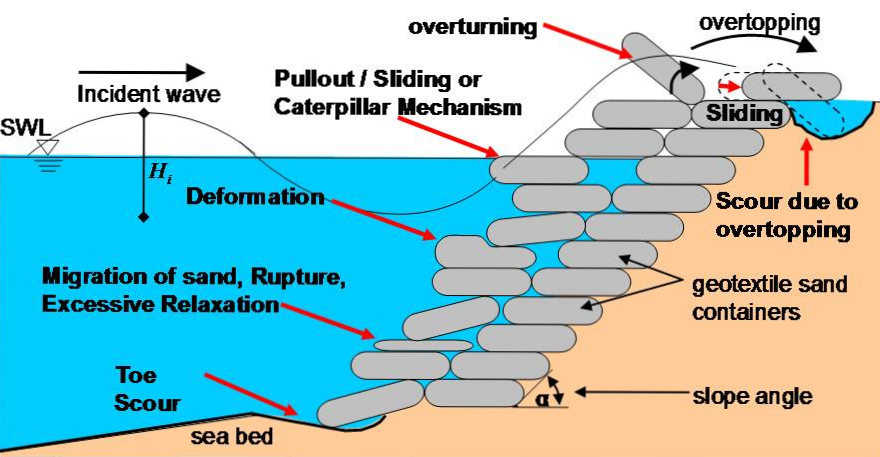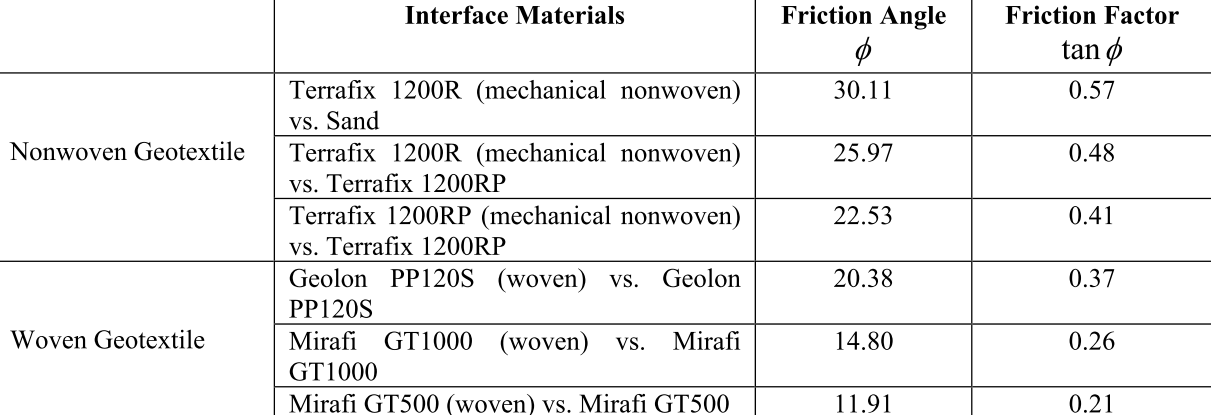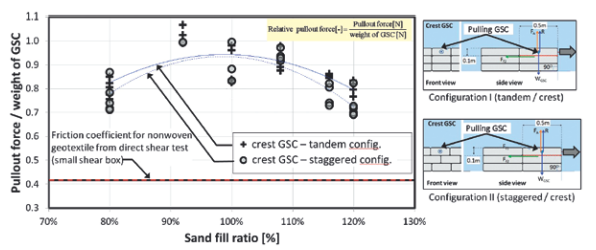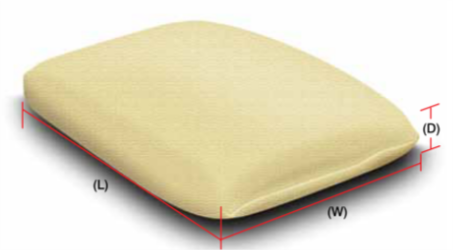Slope of the structure defines the way waves interact with it, and has significant influence on structure stability.
In this calculator only angle of 45° is available.
Wave height to be used is incident significant wave height at the toe of the structure
In this calculator wave height is limited to 4m.
Average period Tm should be used, relation between Tp and Tm (Tp/Tm) lies in range of 1.1-1.25.
Influences both, Basic and Advance theories.
Bear in mind that some of the result will not be applicable if wave regime do not correspond to "shallow water" regime - d/L<0.1.
Wave length is limited to 30s in this Web App.
GCS units are filled with sand-water slurry. Send is mixed with water in order to be hydraulically compacted.
Video courtesy of Geofabrics Australasia
Latest researches are showing difference in behavior between slope bags and crest bags.
First ones' stability is usually governed by sliding resistance, while with latter ones likelihood of failing by overturning in increased.

By defining freeboard of the structure some predictions on crest GSCs can be assessed.
Called "Basic" in this App just to be separated from process-based approach (marked here "Advanced").
Based on numerous large and small tests specially designed to provide stability assessment of GSC structures.
Approach is based on Surf similarity and relative freeboard parameters.
Dassanayake did additional researches and proposed altered stability formulae for low-crested and submerged structures depending on material type and sand-filling ratio, those stability formulae are not part of this Web App at this point
These formulae and assessment have they field of applicability and they cannot be applied to each situation.
Developed by dr Juan Recio,
this is advance theory approach aiming to take GSC stability design on another level by building mathematical model of each failure mechanism on unit level.It is the only process-based hydraulic stability assessment available at this time.
This is an extremely complex approach still to be fully investigated and this calculations given in this Web App are only for demonstration purpose.
Stability calculations taking into account deformation of units is not considered in this App.
Stability calculation for overturning failing mechanism is not considered in this App, only sliding mechanism is taken into consideration.
Do not use this output unless you are fully introduced with theoretical aspects of it.
Extremely important coefficient influencing entire process-based calculation approach, especially sliding resistance.
In the following table some of friction coefficients are given as per Recio's work.

Influence of friction to structure stability depends on many factors, mainly on dominant failure mechanism, which is, again, governed my many factors.
Dassanayake as well did some research on influence of sand fill ratio, type of geotextile, overlapping lengths ans stacking patterns on this parameter by conduction underwater pullout tests(see following image):

Engineer should be cautious while defining this parameter.
Some of the result will not be applicable if wave regime do not correspond to "shallow water" regime - d/L<0.1.
The force coefficients (Cd, Cm and Cl)are highly dependent on water depth-wave length relations.
Another parameter that influences this coefficients is Reynold number, Recio tested units within range of 104<Re<106.
Surface roughness of GSC units as well influences this coefficients, tests are being done only with nonwoven material.
Recio's process based calculation require these coefficients to be assumed as much accurate as possible.
They are influenced by water depth, water length, Reynolds number, units' position inside the structure, surface roughness...
He also introduced coefficients for deformation of the units, but that is not part of this Web app.
Recio's process based calculation require these coefficients to be assumed as much accurate as possible.
They are influenced by water depth, water length, Reynolds number, units' position inside the structure, surface roughness...
He also introduced coefficients for deformation of the units, but that is not part of this Web app.

Photo courtesy of Geofabrics Australasia
- GSC length [m]:
- GSC width [m]:
- GSC height [m]:
- GSC weight [kg]:
-
Dassanayake, D.T. and Oumeraci, H. 2009a.
Experimental and numerical modelling of the hydraulic stability of geotextile sand containers for coastal protection - State of the art report
Internal report, Leichtweiß-Institute for Hydraulic Engineering and Water Resources, Braunschweig, Germany. -
Recio, J. (2007).
Hydraulic stability of geotextile sand containers for coastal structures - effect of deformations and stability formulae
PhD Thesis,Leichweiss-Institute for Hydraulic Engineering and Water Resources. Braunschweig, Germany. -
Dassanayake, D.T., Oumeraci, H. 2009b.
Planned research on the hydraulic stability of geotextile sand containers
7. FZK-Kolloquium, "Potenziale für die Maritime Wirtschaft", Hannover, Germany. -
Dassanayake, D.T., Soysa, A., Munith-Hadi, F., Oumeraci, H. 2011.
Hydraulic stability of low-crested GSC-structures
Internal report, Leichtweiß-Institute for Hydraulic Engineering and Water Resources, Braunschweig, Germany. -
Jackson, L.A., Corbett, B.A., Restall, S.J.(2006)
Failure modes and stability modelling for design of sand filled geosynthetic units in coastal structures Proceedings of 30th International Conference on Coastal Engineering, World Scientific, San Diego, USA -
Dassanayake, D.T., Oumeraci, H. 2012a.
Important engineering properties of geotextile sand containers and their effect on the hydraulic stability of GSC-structures
Terra et Aqua Journal, Issue 127, International Association of Dredging Companies, The Netherlands, 3-11. -
Dassanayake, D.T., Oumeraci, H. 2012b.
Engineering properties of geotextile sand containers and their effect on hydraulic stability and damage development of low-crested / submerged structures
The International Journal of Ocean and Climate Systems, Vol. 3, Issue 3, Multi Science Publishing,Essex, UK, 135-150 -
Dassanayake, D.T., Oumeraci, H. 2012c.
Numerical modelling of the hydraulics stability of GSCs with COBRAS-UC and UDEC 5
Internal report, Leichtweiß-Institute for Hydraulic Engineering and Water Resources, Braunschweig, Germany. -
J.D Fenton, W.D. McKee (2007).
On calculating the lengths of the water Waves.
June 29, 1990
By using the Web App, the user acknowledges that the terms and conditions stated in this page shall apply.
CopyrightAll content belongs to the Ecocoast Contracting LLC and this site's owner unless stated otherwise. Unauthorized use and/or duplication of this material without written permission from the site's owner is strictly prohibited. Excerpts and links may be used, provided that full and clear credit is given to Ecocoast Contracting LLC with appropriate and specific direction to the original content.
Use of dataThe user is free to use the Web App results at his/her own risk. All calculations here are based on public researches and scientific works listed in Reference section. The site's owner is not responsible for possible accidents and damages resulting from decisions based on a personal interpretation of the results. In particular, results of this Web App should never be used to make decisions involving the risk of life or property. This App is not aiming to provide full design calculations, but only to put some light on applicability of this kind of structures.
